- 7 Top Flite Golf Clubs XL for Improved Performance - September 28, 2024
- Top Flite Golf Clubs: Top 5 Reasons to Choose Them - September 28, 2024
- Top 3 Golf Club Fitters for a Perfect Swing - September 28, 2024
You're about to discover that the key to accessing your full golfing potential lies in finding the perfect fit for your golf clubs, as a shaft length that's tailored to your unique physical characteristics can significantly impact your performance on the course. To get started, you'll need to measure your wrist-to-floor distance, which will determine your ideal club length. This personalized approach considers your height, arm length, and posture to optimize performance and comfort. By getting the perfect fit, you can expect improved accuracy, increased driving distance, and a more consistent swing. Now, take the first step in accessing your full golfing potential.
Key Takeaways
- Golf club sizing is crucial, as shaft length directly impacts performance, and standard lengths vary per club type, requiring individualized adjustments.
- Wrist-to-floor measurement is essential for precise club fitting, as it influences club performance, comfort, and is unique to each individual.
- Club length is proportional to height, with adjustments made for height differences, and general guidelines for average heights are available.
- Lie angle and swingweight are critical considerations for correct club length, as they affect club performance, flexibility, and overall fit.
- Custom club fitting can significantly improve performance, with benefits including increased driving distance, improved accuracy, and injury prevention.
Understanding Golf Club Length
When it comes to golf clubs, the length of the shaft plays a crucial role in directly affecting your performance on the course. Club sizing goes beyond a one-size-fits-all approach; it's about discovering the ideal match for your unique physique and swing style.
Standard club lengths act as a starting point, with drivers typically measuring around 45 inches and irons, putters, and wedges varying from 35 to 35.5 inches. Nonetheless, these measurements may require adjustments based on your height. Taller golfers might need to add half an inch to an inch to their club length, while shorter golfers might need to subtract the same amount.
It's vital to take into account your wrist crease when determining the perfect club length. When you grip the club, the wrist crease should align with the top of the shaft. By considering these aspects, you can ensure a comfortable stance, correct swing mechanics, and improved control over the ball.
Understanding the significance of shaft length will set you on the right path to mastering the art of club sizing and elevating your game to new heights.
Measuring Wrist-to-Floor Distance
To get an accurate measurement of your wrist-to-floor distance, stand up straight with your arms hanging relaxed by your sides. This measurement will serve as a key factor in determining the best length of your golf clubs.
This measurement is essential, as it impacts the overall fit of your clubs and, ultimately, your performance on the course.
Here's how to take your wrist-to-floor measurement correctly:
- Stand up straight: Maintain good posture to ensure a precise measurement.
- Relax your arms: Let your arms hang straight down, with no tension or bending.
- Measure from wrist to floor: Record the distance from the crease of your wrist to the floor. This will give you your wrist-to-floor measurement.
Keep in mind that your wrist-to-floor measurement is unique to you and can vary based on factors like posture, arm length, and swing style.
By using a club length chart and considering your wrist-to-floor measurement, you'll be able to determine the best length of your golf clubs for improved performance.
With this measurement, you'll be one step closer to finding the perfect fit for your golf clubs.
Importance of Club Fitting
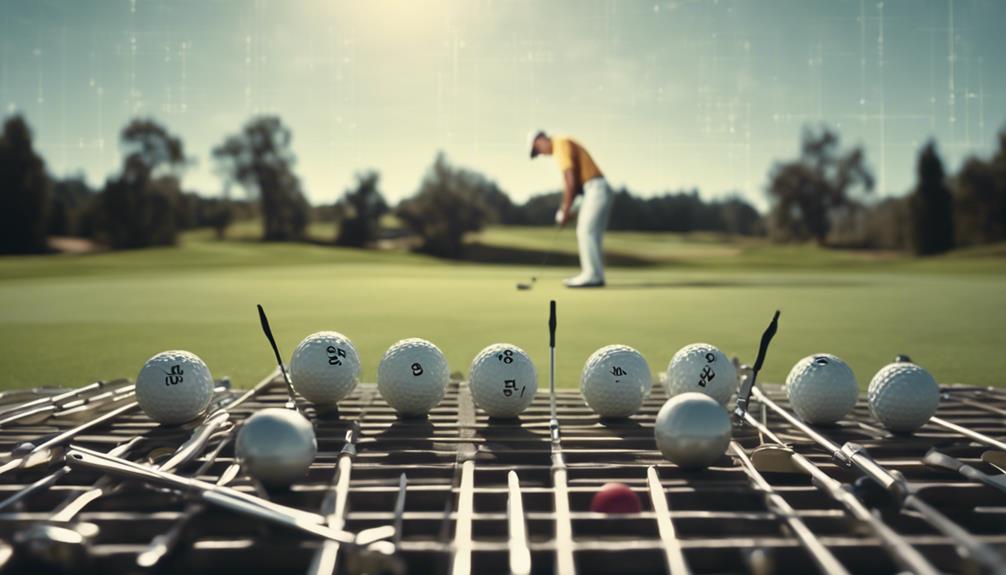
By recognizing the vital role that club fitting plays in optimizing your golf game, you can access improved performance, enhanced comfort, and increased confidence on the course.
A proper club fit ensures that your clubs are tailored to your unique physical characteristics, swing style, and preferences. This personalized approach helps you achieve peak performance by correcting any flaws in your swing mechanics and posture.
Incorrectly fitted clubs, on the other hand, can lead to poor posture, swing mechanics, and accuracy, ultimately affecting your overall game.
Golf club fitting involves considering factors like height, wrist-to-floor measurement, arm length, and swingweight to determine the best club specifications, including club length and club head design.
By getting your clubs fitted professionally, you can enjoy a more comfortable and consistent swing, resulting in better scores and a more enjoyable golfing experience.
Don't underestimate the significance of club fitting – it's an essential step in taking your game to the next level.
Height-Based Club Length Chart
When determining your ideal club length, you'll need to contemplate your height and its proportional relationship to club length.
As you'll see in the height-based club length chart, for every 5-6 inches of height difference, the club length should adjust by about 1 inch.
Height and Proportion
You can use your height to estimate the ideal club length, with charts suggesting that for every 5-6 inches of height difference, the clubs should be adjusted by about 1 inch. This proportion-based approach is a good starting point for determining your club length.
Here are some general guidelines based on average heights:
- The average woman, standing at around 5'5', would require a club length that's suitable for their height range, which is typically between 5'2' and 5'7'.
- The average male, standing at around 5'10', would require a club length that's suitable for their height range, which is typically between 5'6' and 5'11'.
- Keep in mind that these are general guidelines, and your wrist-to-floor measurement may also influence your ideal club length, as it's typically around 48.9% of your height.
Measurement Variations
Using height-based charts, you can fine-tune your club length by referencing measurement variations that account for individual differences within a given height range. As a golfer, your height and proportions play a noteworthy role in determining the ideal golf club length.
For instance, the average woman's height is approximately 5'5', with about 68% of women falling between 5'2' and 5'7'. Similarly, the average male is around 5'10', with nearly 68% between 5'6' and 5'11'. Charts use proportions, such as adjusting club length by 1' for every 5-6' of height differential.
When consulting a club fitter, they'll often use the WTF (wrist-to-floor) measurement method, which recommends club length based on the ratio of your height. On average, this measurement is around 48.9% of your overall height.
Lie Angle and Swingweight Factors
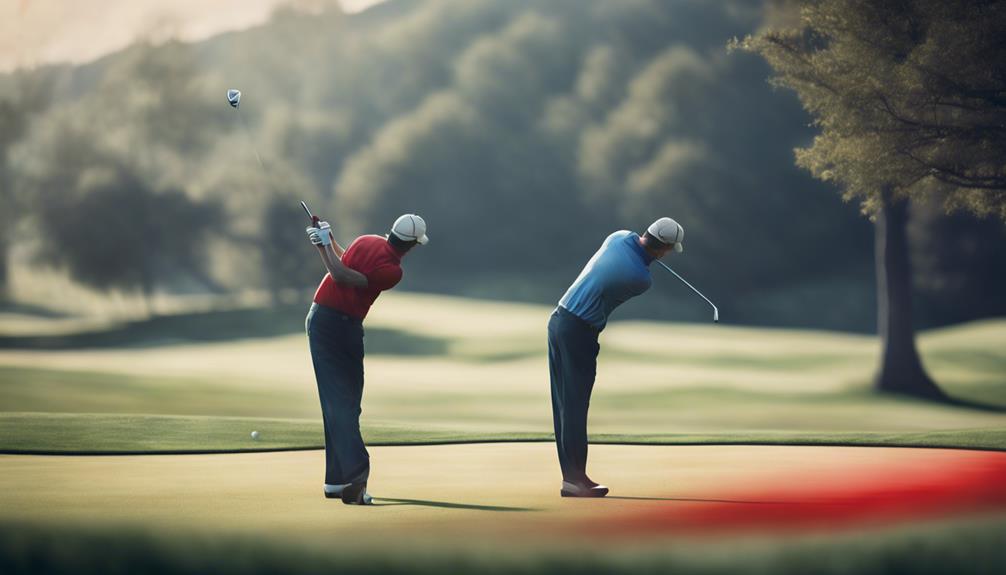
The lie angle of a golf club plays a critical role in determining its overall length, as each 1° increase in lie raises the butt end of the club by about 1/3'. This means that even small adjustments to the lie angle can have a significant impact on the club's length.
When you think about your ideal club length, factoring in the lie angle is crucial for a perfect fit.
Manufacturers often adjust the lie angle to achieve the correct club length without changing the physical length. This is because different combinations of length and lie can lead to the same swingweight, offering flexibility in club customization.
Here are three key takeaways to keep in mind:
- Lie angle influences club length: Each 1° increase in lie raises the butt end of the club by about 1/3'.
- Swingweight is a crucial factor: Various combinations of length and lie can result in the same swingweight, allowing for customization.
- Proper consideration is vital: You must consider both lie angle and swingweight to determine the correct club length for your game.
Alternative Club Length Methods
Beyond lie angle and swingweight considerations, alternative methods for determining club length focus on physical characteristics, such as arm length, hand size, and height, to find the perfect fit.
You'll find that some manufacturers recommend club length based on a combination of your height and wrist-to-floor measurement. This approach takes into account your unique physical characteristics to ensure a comfortable and effective swing.
Tools like Hireko's GetFit Online Golf Fitting Tool can also assist you in determining the right club length and lie angle. By taking into account your arm length, hand size, and other physical characteristics, you can experiment with different clubs and lengths to find the best fit for your swing and posture.
Unique Fitting Situations and Exceptions
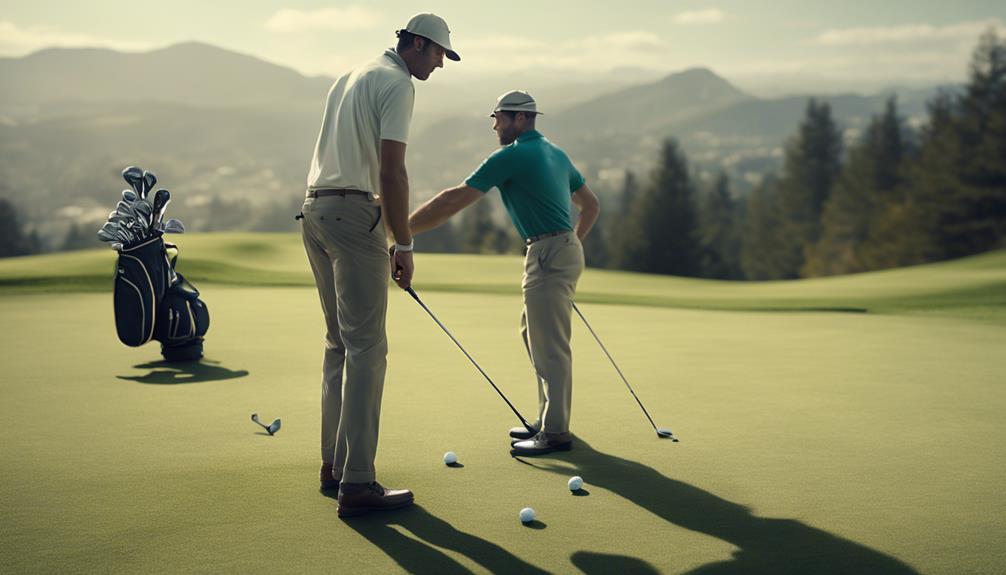
You may come across situations where standard club fitting guidelines don't apply, such as when physical abnormalities or unique body proportions require special consideration. In these cases, a one-size-fits-all approach won't work, and you'll need a more tailored approach to find the perfect fit.
Here are some examples of unique fitting situations that may require custom club fitting:
- Unusual arm length: If you have arms that are notably longer or shorter than average, you may need longer clubs or a shorter club to accommodate your swing.
- Postural irregularities: Golfers with uncommon postures, such as a pronounced sway or forward lean, may need clubs that are adjusted to compensate for their stance.
- Physical limitations: Injuries or physical abnormalities, such as arthritis or joint replacements, may require special consideration when fitting clubs to ensure a comfortable and effective swing.
In these situations, a custom club fitting can make all the difference. A professional club fitter can work with you to tailor clubs to your unique needs, guaranteeing that you get the most out of your game.
Don't settle for a generic fit – invest in a custom club fitting to elevate your game to the next level.
Benefits of Professional Club Fitting
Properly fitted clubs can reveal significant improvements in your game, yielding tangible benefits that extend far beyond a simple tune-up. By investing in professional club fitting, you can discover the full potential of your swing, resulting in substantial gains in distance and accuracy.
Data shows that properly fitted clubs can lead to an average of 20 more yards in driving distance and 6-8 fewer strokes per round. In fact, a study found that 90% of golfers who were custom fit saw an improvement in their game, with 80% seeing a noticeable increase in accuracy and distance.
Additionally, professional club fitting can help prevent injury by ensuring proper posture, swing mechanics, and reduced strain on the body. By getting the right golf clubs, tailored to your unique swing characteristics, you can enhance your golf and enjoy the game more.
With the right club length, lie angle, and weight, you'll be able to make consistent, precise shots that leave you feeling confident and in control.
How to Prepare for Club Fitting
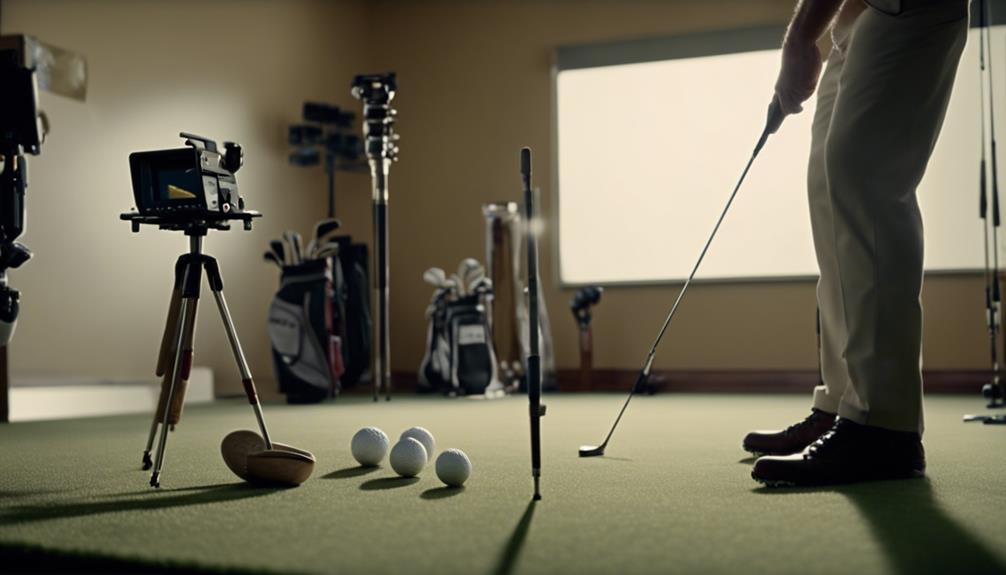
To get the most out of your club fitting experience, it's vital that you're physically and mentally prepared, as this session will help tailor clubs to your unique swing characteristics and goals.
Before the fitting session, take some time to prepare. Here are a few things to keep in mind:
- Dress comfortably: Wear comfortable clothing and golf shoes to secure accurate measurements. This will help you feel relaxed and natural during the fitting process.
- Bring your current clubs: Bring your current clubs to the fitting session to aid the fitter in understanding your preferences and performance. This will give them a better understanding of what you're working with.
- Be prepared to discuss your game: Be ready to discuss your golfing goals, strengths, weaknesses, and any physical limitations or injuries. This will help the fitter tailor their recommendations to your specific needs.
Tips for Choosing the Right Grip
Selecting the appropriate grip size is crucial, as it directly impacts your overall golfing experience, influencing factors such as hand fatigue, grip pressure, and club control. When it comes to choosing the perfect grip, you'll want to take into account your hand size and personal preferences.
Golf grips come in various sizes, ranging from undersize to jumbo, so it's vital to find the one that fits you best. A grip that's too small can cause hand fatigue, while one that's too large can lead to inconsistent grip pressure. To determine your ideal grip size, measure the circumference of your hands around the knuckles. This will help you select the right grip size, which can range from 0.580 to 0.600 inches in diameter.
A professional club fitter can also evaluate your hand size and recommend the optimal grip size to help you play better golf. By getting the right grip size, you'll be able to maintain a consistent swing and improve your overall game. The correct grip size will help you play better golf, and with the right guidance, you can find the perfect fit for your Golf Club Size.
Customization Options for Golfers
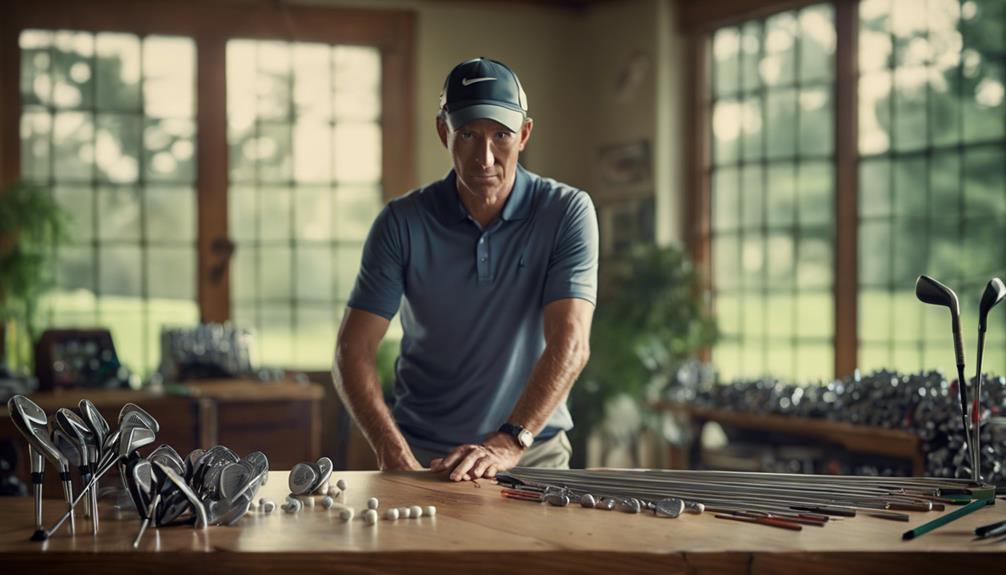
Beyond grip size, golfers can fine-tune their equipment through various customization options, including adjustments to club length, lie angle, and shaft material, to create a tailored fit that optimizes their performance. By considering your physical characteristics, such as height, arm length, and posture, you can get clubs that are tailored to your unique needs.
This is where custom fitting comes in – a process that guarantees the right club length and specifications for your game.
Here are three key factors that professional club fitters consider when customizing clubs:
- Wrist-to-Floor Measurements: This helps determine the ideal club length for your swing.
- Arm Length and Posture: These factors influence the lie angle and shaft material that's best for you.
- Swing Style and Weight: This affects the overall feel and performance of your clubs.
With customized clubs, you can expect improvements in comfort, accuracy, distance, and overall enjoyment of the game. By taking the time to fine-tune your equipment, you'll be able to take your game to new heights.
Taking Your Game to the Next Level
As you look to take your game to the next level, focusing on club fitting basics that optimize your performance is crucial.
You'll want to start by getting your club length precisely right, as this can greatly impact your ball contact, accuracy, and distance.
Club Fitting Essentials
To enhance your game, you need to get equipped with the right clubs, a process that involves more than just selecting a club off the shelf and hoping it works for you. Club fitting essentials are vital for achieving a perfect golf game. A professional club fitting session can help you maximize your full potential by providing you with the best-suited equipment for your individual needs.
Here are three key aspects of club fitting essentials:
- Height and wrist-to-floor measurement: These factors are used to determine the appropriate club length and lie angle that fits your physical characteristics.
- Swing style and preferences: A professional fitter will assess your swing to recommend the optimal club head design, shaft material, and grip size.
- Personalized club setup: By taking into account your unique characteristics, a fitter can provide you with a tailored club setup that guarantees a consistent and dependable swing.
Proper Club Length
Optimizing your club length sets the foundation for a consistent and accurate swing, allowing you to reveal your full potential and take your game to the next level.
To achieve this, you need to find the right club length tailored to your individual needs. Your height would indicate the ideal club length, and taking wrist-to-floor measurements can also help you determine the perfect fit.
When trying out a set of clubs, pay attention to how they feel in your hands. Do you feel comfortable and balanced, or do the clubs seem too long or too short?
A professional custom fitting can also help you find the perfect club length, taking into account your body and swing characteristics. Investing in the right club length can lead to better performance, consistent results, and an overall more enjoyable golfing experience.
Frequently Asked Questions
How Do You Size Golf Clubs for Your Height?
When sizing golf clubs for your height, you'll start on a personalized club fitting process, considering custom options, proper grip size, and potential swing adjustments to guarantee a tailored fit that optimizes your game.
How to Measure Golf Clubs to Fit You?
"Just as a tailor measures every inch of your body for a bespoke suit, you must meticulously measure yourself to fit golf clubs to your unique specs, considering grip size, shaft length, club head size, and swing weight for a seamless swing."
How Do You Know if Your Golf Clubs Are Too Big?
You'll know your golf clubs are too big if you struggle with grip size, shaft length, or club head weight, or if your swing speed suffers, causing poor control, inconsistent strikes, and lack of power.
How to Tell if Golf Clubs Are Too Short?
Are you struggling to find the sweet spot? If you're hunching over or experiencing discomfort, your clubs might be too short. Measure your arm length and grip comfort, and assess your swing consistency; consider a professional fitting to guarantee the perfect fit.
Conclusion
You've taken the important step of sizing your golf clubs for a perfect fit. Now, get ready to access your full potential on the course.
Notably, a study by the PGA of America found that 90% of golfers play with clubs that are the wrong size, resulting in significant losses in distance and accuracy. By investing time in club fitting, you'll be part of the exclusive 10% who reap the benefits of optimized performance.
Take your game to the next level and experience the difference a perfectly fitted club can make.




